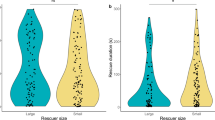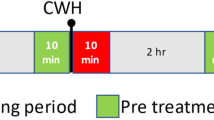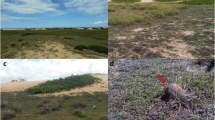Abstract
In social insects, behavioral changes are shaped by social context which includes the presence of other castes. Soldiers play a critical role in the defense of a termite colony, although their role beyond defense is less understood. Termites tunnel to safely acquire resources, producing an extended phenotype of the colony shaped by various environmental and genetic factors. In this study, we investigated the indirect influence of the soldier on worker tunneling behavior for three species of Reticulitermes subterranean termites. Groups of 50 worker termites containing either three, one, none, or the cuticular extract of soldiers were placed into planar arenas and allowed to tunnel. The speed and morphology of tunnel construction were determined for the first 36 h of tunneling. We found tunneling differences among species: R. flavipes (Kollar) produced more branches and tunneled faster than both R. hageni Banks and R. virginicus (Banks). Trials with live soldiers produced more branches in R. flavipes, while trials with live soldiers or even the chemical extract of a soldier increased tunnel speed in R. flavipes and accelerated tunnel initiation in R. hageni. In R. virginicus, there was little impact of soldiers. These behavioral changes in R. flavipes and R. hageni may reduce the chance of tunneling workers encountering enemies without soldiers present. All three species used dead reckoning to maintain a straight direction after being forced through two sharp turns, but the presence of soldiers had no influence on this ability. This study, showing that soldiers can influence tunneling behavior in workers in some species, provides additional evidence of the keystone role of soldiers in termite colonies, and demonstrates that this influence can be exerted through chemical cues alone in some species.







Similar content being viewed by others
References
Alibert J (1968) Influence de la société et de l’individu sur la trophallaxie chez Calotermes flavicollis Fabr. et Cubitermes fungifaber (Isoptera). In: Chauvin R, Noirot C (eds) L’effet de Groupe Chez les Animaux. Coll. Int. CNRS, Paris, pp 237–288
Austin JW, Szalanski AL, Messenger MT (2004) Mitochondrial DNA variation and distribution of the subterranean termite genus Reticulitermes (Isoptera: Rhinotermitidae) in Arkansas and Louisiana. Fla Entomol 87:473–480
Bagnères AG, Clément JL, Blum MS, Severson RF, Joulie C, Lange C (1990) Cuticular hydrocarbons and defensive compounds of Reticulitermes flavipes (Kollar) and R. santonensis (Feytaud): polymorphism and chemotaxonomy. J Chem Ecol 16:3213–3244
Bardunias P, Su N-Y (2009) Dead reckoning in tunnel propagation of the Formosan subterranean termite (Isoptera: Rhinotermitidae). Ann Entomol Soc Am 102:158–165
Casarin FE, Costa-Leonardob AM, Arab A (2008) Soldiers initiate foraging activities in the subterranean termite, Heterotermes tenuis. J Insect Sci 8:1–5
Chouvenc T, Bardunias P, Li H-F, Elliott ML, Su N-Y (2011) Planar arenas for use in laboratory bioassay studies of subterranean termites (Rhinotermitidae). Fla Entomol 94:817–826
Cook CN, Breed MD (2013) Social context influences the initiation and threshold of thermoregulatory behaviour in honeybees. Anim Behav 86:323–329
DeHeer CJ, Vargo EL (2008) Strong mitochondrial DNA similarity but low relatedness at microsatellite loci among families within fused colonies of the termite Reticulitermes flavipes. Insectes Soc 55:190–199
Forschler BT, Jenkins TM (1999) Evaluation of subterranean termite biology using genetic, chemotaxonomic, and morphometric markers and ecological data: a testimonial for multi-disciplinary efforts. Trends Entomol 2:71–80
Francfort R (1945) Quelques phénomènes illustrant l’influence de la fourmilière sur les fourmis isolées. Bull Soc Entomol Fr 50:95–96
Grace JK (1996) Temporal and spatial variation in caste proportions in a northern Reticulitermes flavipes colony (Isoptera: Rhinotermitidae). Sociobiology 28:225–231
Grace JK, Aihara-Sasaki M, Yates JR (2004) Differences in tunneling behavior of Coptotermes vastator and Coptotermes formosanus (Isoptera: Rhinotermitidae). Sociobiology 43:153–158
Hapukotuwa NK, Grace JK (2014) Do tunnel patterns of Coptotermes formosanus and Coptotermes gestroi (Blattodea: Rhinotermitidae) reflect different foraging strategies? Sociobiology 59:189–202
Haverty MI (1977) The proportion of soldiers in termite colonies: a list and a bibliography. Sociobiology 2:199–216
Haverty MI, Howard RW (1981) Production of soldiers and maintenance of soldier proportions by laboratory experimental groups of Reticulitermes flavipes (Kollar) and Reticulitermes virginicus (Banks) (Isoptera: Rhinotermitidae). Insectes Soc 28:32–39
Haverty MI, Nutting WL, Lafage JP (1975) Density of colonies and spatial distribution of foraging territories of the desert subterranean termite, Heterotermes aureus (Snyder). Environ Entomol 4:105–109
Hedlund JC, Henderson G (1999) Effect of available food size on search tunnel formation by the Formosan subterranean termite (Isoptera: Rhinotermitidae). J Econ Entomol 92:610–616
Houseman RM, Gold RE (2003) Factors that influence tunneling in the eastern subterranean termite, Reticulitermes flavipes (Kollar) (Isoptera: Rhinotermitidae). J Agric Urban Entomol 20:69–81
Ishikawa Y, Miura T (2012) Hidden aggression in termite workers: plastic defensive behaviour dependent upon social context. Anim Behav 83:737–745
Jammalamadaka SR, SenGupta A (2001) Topics in circular statistics. World Scientific, Singapore
Jaycox ER (1970) Honey bee queen pheromones and worker foraging behavior. Ann Entomol Soc Am 63:222–228
Kohlmeier P, Negroni MA, Kever M, Emmling S, Stypa H, Feldmeyer B, Foitzik S (2017) Intrinsic worker mortality depends on behavioral caste and the queens’ presence in a social insect. Sci Nat-Heidelberg 104:34
Konishi T, Matsuura K (2021) Royal presence promotes worker and soldier aggression against non-nestmates in termites. Insectes Soc 68:15–21
Lee S-H, Bardunias P, Su N-Y (2006) Food encounter rates of simulated termite tunnels with variable food size/distribution pattern and tunnel branch length. J Theor Biol 243:493–500
Lee S-H, Bardunias P, Su N-Y (2007) Optimal length distribution of termite tunnel branches for efficient food search and resource transportation. Biosystems 90:802–807
Lefeuve P, Bordereau C (1984) Soldier formation regulated by a primer pheromone from the soldier frontal gland in a higher termite, Nasutitermes lujae. Proc Natl Acad Sci USA 81:7665–7668
Matsuura K (2002) Colony-level stabilization of soldier head width for head-plug defense in the termite Reticulitermes speratus (Isoptera: Rhinotermitidae). Behav Ecol Sociobiol 51:172–179
Matsuura K (2006) Termite-egg mimicry by a sclerotium-forming fungus. Proc R Soc B 273:1203–1209
Mitaka Y, Mori N, Matsuura K (2017) Multi-functional roles of a soldier-specific volatile as a worker arrestant, primer pheromone and an antimicrobial agent in a termite. Proc R Soc B 284:20171134
Mizumoto N, Bardunias PM, Pratt SC (2019) Parameter tuning facilitates the evolution of diverse tunneling patterns in termites. bioRxiv. https://doi.org/10.1101/836346
Modlmeier AP, Keiser CN, Watters JV, Sih A, Pruitt JN (2014) The keystone individual concept: an ecological and evolutionary overview. Anim Behav 89:53–62
Nelson LJ, Cool LG, Forschler BT, Haverty MI (2001) Correspondence of soldier defense secretion mixtures with cuticular hydrocarbon phenotypes for chemotaxonomy of the termite genus Reticulitermes in North America. J Chem Ecol 27:1449–1479
Parman V, Vargo EL (2008) Population density, species abundance, and breeding structure of subterranean termite colonies in and around infested houses in central North Carolina. J Econ Entomol 101:1349–1359
Pitts-Singer TL, Forschler BT (2000) Influence of guidelines and passageways on tunneling behavior of Reticulitermes flavipes (Kollar) and R. virginicus (Banks)(Isoptera: Rhinotermitidae). J Insect Behav 13:273–290
R Core Team (2013) R: a language and environment for statistical computing. R Foundation for Statistical Computing, Vienna, Austria
Reinhard J, Clément J-L (2002) Alarm reaction of European Reticulitermes termites to soldier head capsule volatiles (Isoptera, Rhinotermitidae). J Insect Behav 15:95–107
Reinhard J, Kaib M (2001) Trail communication during foraging and recruitment in the subterranean termite Reticulitermes santonensis De Feytaud (Isoptera, Rhinotermitidae). J Insect Behav 14:157–171
Reinhard J, Hertel H, Kaib M (1997) Systematic search for food in the subterranean termite Reticulitermes santonensis De Feytaud (Isoptera, Rhinotermitidae). Insectes Soc 44:147–158
Roisin Y, Everaerts C, Pasteels JM, Bonnard O (1990) Caste-dependent reactions to soldier defensive secretion and chiral alarm/recruitment pheromone in Nasutitermes princeps. J Chem Ecol 16:2865–2875
Scheffrahn RH, Su N-Y (1994) Keys to soldier and winged adult termites (Isoptera) of Florida. Fla Entomol 77:460–474
Šobotník J, Jirošová A, Hanus R (2010) Chemical warfare in termites. J Insect Physiol 56:1012–1021
Su N-Y, Stith BM, Puche H, Bardunias P (2004) Characterization of tunneling geometry of subterranean termites (lsoptera: Rhinotermitidae) by computer. Sociobiology 44:471–483
Sun Q, Haynes KF, Zhou X (2016) Dynamic changes in death cues modulate risks and rewards of corpse management in a social insect. Funct Ecol 31:697–706
Tarver MR, Schmelz EA, Rocca JR, Scharf ME (2009) Effects of soldier-derived terpenes on soldier caste differentiation in the termite Reticulitermes flavipes. J Chem Ecol 35:256–264
Thorne BL (1982) Termite-termite interactions: Workers as an agonistic caste. Psyche 89:133–150
Tian L, Zhou X (2014) The soldiers in societies: defense, regulation, and evolution. Int J Biol Sci 10:296–308
Tian L, Preisser EL, Haynes KF, Zhou X (2017) Social buffering in a eusocial invertebrate: termite soldiers reduce the lethal impact of competitor cues on workers. Ecology 98:952–960
Traniello JF (1981) Enemy deterrence in the recruitment strategy of a termite: soldier-organized foraging in Nasutitermes costalis. Proc Natl Acad Sci USA 78:1976–1979
Vargo EL, Juba TR, DeHeer CJ (2006) Relative abundance and comparative breeding structure of subterranean termite colonies (Reticulitermes flavipes, Reticulitermes hageni, Reticulitermes virginicus, and Coptotermes formosanus) in a South Carolina lowcountry site as revealed by molecular markers. Ann Entomol Soc Am 99:1101–1109
Waller DA (2007) Termite resource partitioning related to log diameter. Northeast Nat 14:139–144
Wilson EO (1971) The insect societies. Belknap Press, Cambridge
Zalkow LH, Howard RW, Gelbaum LT, Gordon MM, Deutsch HM, Blum MS (1981) Chemical ecology of Reticulitermes flavipes (Kollar) and R. virginicus (Banks)(Rhinotermitidae). J Chem Ecol 7:717–731
Acknowledgements
We thank Thomas Chouvenc and Ron Pepin for assistance learning to make planar arenas. Also, thanks to Taylor Wade for assistance in the lab. This research was supported by the Urban Entomology Endowment and the Dr. Roger E. Gold Endowed Graduate Scholarship at Texas A&M University.
Author information
Authors and Affiliations
Contributions
MAJ and ELV conceived and designed the project. MAJ collected and analyzed the data. MAJ wrote the manuscript with contributions from ELV.
Corresponding author
Ethics declarations
Conflict of interest
The authors declare no competing interests.
Rights and permissions
About this article
Cite this article
Janowiecki, M.A., Vargo, E.L. Effect of soldiers on collective tunneling behavior in three species of Reticulitermes (Blattodea: Rhinotermitidae). Insect. Soc. 69, 237–245 (2022). https://doi.org/10.1007/s00040-022-00864-6
Received:
Revised:
Accepted:
Published:
Issue Date:
DOI: https://doi.org/10.1007/s00040-022-00864-6




